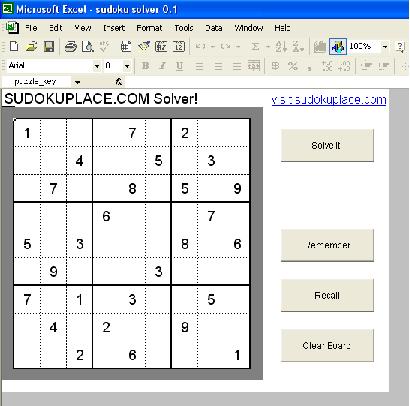
Excel Sudoku Solver Code
A typical Sudoku puzzle A standard contains 81 cells, in a 9×9 grid, and has 9 boxes, each box being the intersection of the first, middle, or last 3 rows, and the first, middle, or last 3 columns. Each cell may contain a number from one to nine, and each number can only occur once in each row, column, and box. A Sudoku starts with some cells containing numbers ( clues), and the goal is to solve the remaining cells. Proper Sudokus have one solution.
Players and investigators may use a wide range of computer algorithms to solve Sudokus, study their properties, and make new puzzles, including Sudokus with interesting symmetries and other properties. There are several computer algorithms that will solve most 9×9 puzzles ( n=9) in fractions of a second, but occurs as n increases, creating limits to the properties of Sudokus that can be constructed, analyzed, and solved as n increases. Main article: Some hobbyists have developed computer programs that will solve Sudoku puzzles using a backtracking algorithm, which is a type of brute force search. Backtracking is a depth-first search (in contrast to a breadth-first search), because it will completely explore one branch to a possible solution before moving to another branch.
• Castells 2001, p140. And the ellipsis in the quote covers the anti-trust law suit against Microsoft, at the time. Castells the internet galaxy pdf compressor. • Castells 2001, p130.
Excel spreadsheet that solves Sudoku puzzles. Choice of algorithms, so you can step through a puzzle. This isn't the fastest solver, but we like watching it think. Building a Basic, Understandable Sudoku Solver Using Excel Iterative Calculation – Part 1/2 By Diego Oppenheimer, on September 30, 2008 Today’s author, Charlie Ellis, a Program Manager on the Excel team, shares a spreadsheet he built in Excel for solving Sudoku puzzles.
Although it has been established that approximately 5.96 x 11 26 final grids exist, a brute force algorithm can be a practical method to solve Sudoku puzzles. A brute force algorithm visits the empty cells in some order, filling in digits sequentially, or backtracking when the number is found to be not valid. Briefly, a program would solve a puzzle by placing the digit '1' in the first cell and checking if it is allowed to be there.

If there are no violations (checking row, column, and box constraints) then the algorithm advances to the next cell, and places a '1' in that cell. When checking for violations, if it is discovered that the '1' is not allowed, the value is advanced to '2'. If a cell is discovered where none of the 9 digits is allowed, then the algorithm leaves that cell blank and moves back to the previous cell. The value in that cell is then incremented by one. This is repeated until the allowed value in the last (81st) cell is discovered. The animation shows how a Sudoku is solved with this method. The puzzle's clues (red numbers) remain fixed while the algorithm tests each unsolved cell with a possible solution.